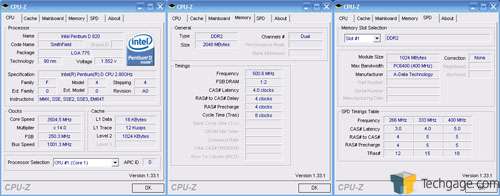- Qualcomm Launches Snapdragon 4 Gen 2 Mobile Platform
- AMD Launches Ryzen PRO 7000 Series Mobile & Desktop Platform
- Intel Launches Sleek Single-Slot Arc Pro A60 Workstation Graphics Card
- NVIDIA Announces Latest Ada Lovelace Additions: GeForce RTX 4060 Ti & RTX 4060
- Maxon Redshift With AMD Radeon GPU Rendering Support Now Available
A-Data 2GB PC2-8000 Vitesta Extreme Edition

If you are thinking of jumping onto the PC2-8000 bandwagon, there is surprisingly much more choice now than there was just two months ago. Like other PC2-8000 kits we have tested, A-Datas is seriously fast, but is it worth your hard earned cash?
Page 2 – Technical Specifications
|
|
If you haven’t caught on by now… these are PC2-8000 modules, also known as DDR2-1000. They are classified as “Extreme Edition” for their speed, and probably their overclocking potential. Though, the stock 5-5-5-15 timings are nothing really to be called ‘extreme’. Upon asking around, these sticks seem to use Micron D9GKX chips, which are binned at 400MHz 2.5ns, CL5. These are some of the most expensive, if not the most expensive, chips that Micron has to offer. Why A-Data did not go with the equally performing, but less expensive D9GMH or similar chips is unknown. Regardless, I had a blast using the GKX chips in the Super Talent PC6400 kit, so I couldn’t wait to get down and dirty with my overclocking business with these.
One thing to note also is that these sticks are not dual spec’d, but triple spec’d! This means that they should work out of the box at any of the listed settings. However, who is going to fork out ~$400 for a kit of memory and run it at DDR2-667? Crazy people, that’s who. Out of the box though, they will function at DDR2-667, with 4-4-4-8 timings. It’s up to you to manually change the settings to allow for the DDR2-1000 speeds.
Though there are 1066MHz modules on the market, 1000MHz is still really the cream of the crop when it comes to DDR2. So how do these overclock?
Since these modules use the D9GKX chips, I knew I was in for a similar experience to what I had with the Super Talent sticks. That proved quite true.
- Stable Overclocks
- 400MHz 200FSB 3-3-3-8 2.4v
- 445MHz 267FSB 4-4-4-8 2.2v
- 467MHz 280FSB 4-4-4-12 2.2v
- 500MHz 250FSB 5-5-5-15 2.2v (Stock)
- 500MHz 250FSB 4-4-4-12 2.2v
- 500MHz 250FSB 4-4-3-12 2.3v
- 520MHz 260FSB 4-4-4-8 2.4v
If you check back to that review, you will see that these results are incredibly similar. Though I was able to push past 520MHz, I would error instantly in MemTest, so I left them alone. DDR2-1040 with 4-4-4-8 timings proved stable through a 32Million Super Pi run.
As you can see by the results also, these modules seem to love voltage. All of the results you see are with the lowest voltage required. While some settings seemed to function fine with lower voltage, MemTest would tell me different. One thing I have to question is as to why they don’t ship these with 4-4-4 stock timings. On both GKX kits I have used, they were ultra stable with 4-4-4 with no sign of any error. If I was a company who was responsible for buying these very expensive chips, I would be sure to make the modules look as appealing as possible, which 4-4-4 would help. Though on the other side of the coin, if they are indeed rated otherwise, it could drive up prices for consumers.
Throughout all of our benchmarks regardless of what we are reviewing, testing is done in a clean and stand-alone version of Windows XP Professional with SP2. Prior to testing, these conditions are met:
- Desktop and scrap files are cleaned up, including emptying of recycle bin.
- No virus scanner or firewall is installed in the stand-alone installation.
- The stand-alone installation drive is completely defragged using Diskeeper 10 Pro Premier.
- All unnecessary programs are closed, so that Windows should have no more than 15 active processes running.
- Computer has proper airflow.
If you are interested in using the same benchmarks as us, feel free to visit the developers website:
The testing rig used for today’s benchmarking is as follows:
- CPU: Pentium D 820 (2.8GHz – 3.92GHz)
- Motherboard: ASUS P5WD2-E Premium w/ 401 BIOS
- Memory: A-Data Vitesta 2GB PC2-8000
- Video: BFG 6800GT OC 256MB PCI-E
- Sound: Realtek HD Audio
- Storage: WD 200GB 7200 8MB
- Etcetera: Windows XP Professional w/ SP2, NVIDIA 81.98 Drivers
- Cooling: Corsair Nautilus 500
There are a few things to mention before checking out the results. First, realize that all testing is performed on a rather weak Intel. The 820 D is on a locked multiplier, so I am limited to how high my FSB can go before I have an instable system. In my case, my max stable FSB is 280. Also, bandwidth results will be -far- different here than what you see coming out of AM2 and Conroe. I will have a comparison with a similar PC2-8000 kit later on so you can see some differences on a single system.
|
|
Support our efforts! With ad revenue at an all-time low for written websites, we're relying more than ever on reader support to help us continue putting so much effort into this type of content. You can support us by becoming a Patron, or by using our Amazon shopping affiliate links listed through our articles. Thanks for your support!






